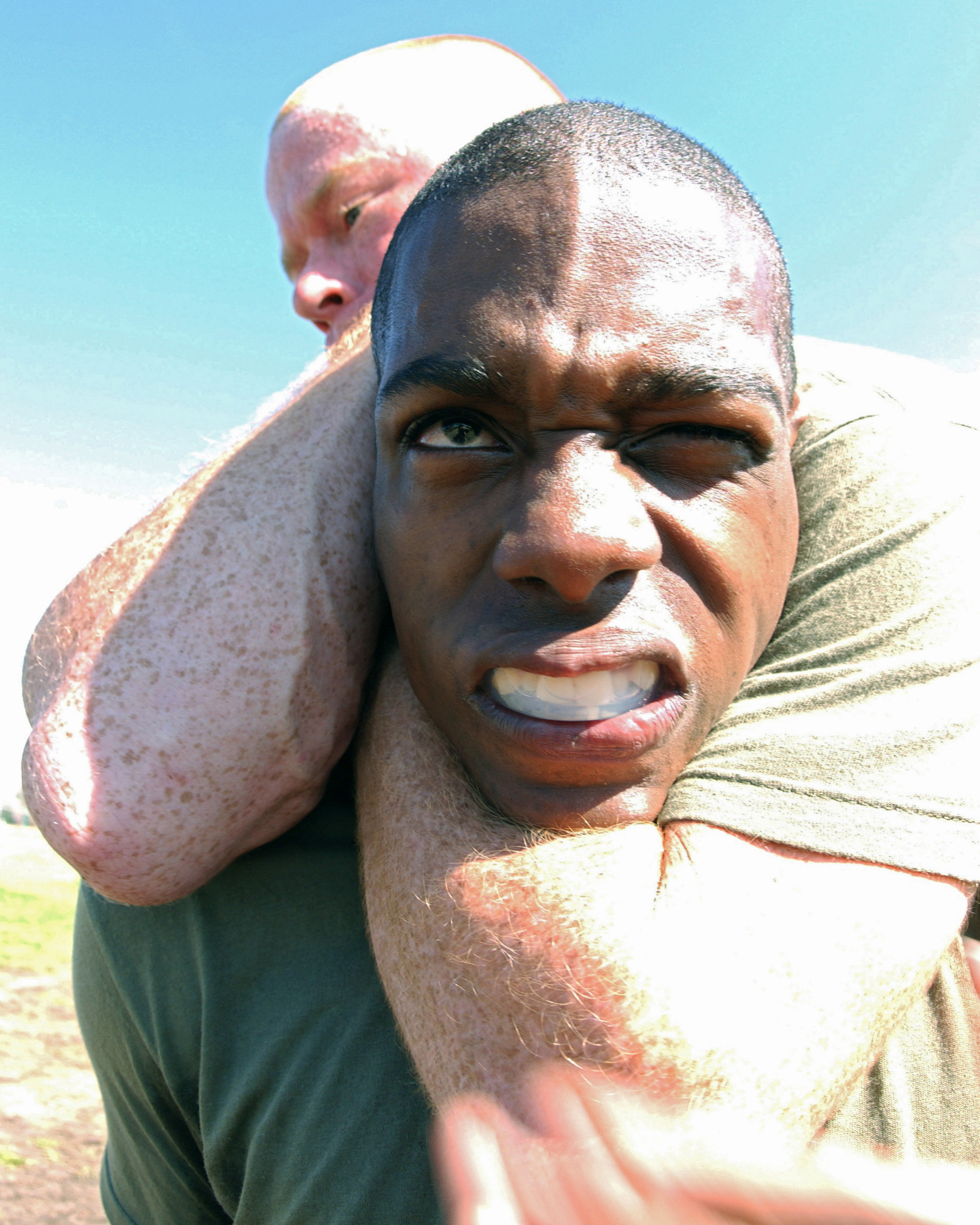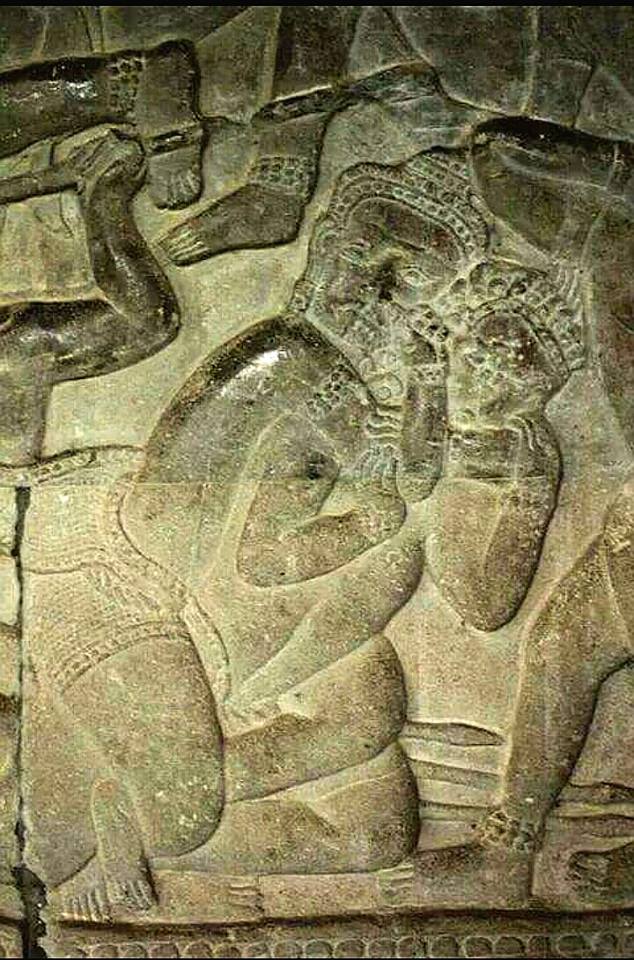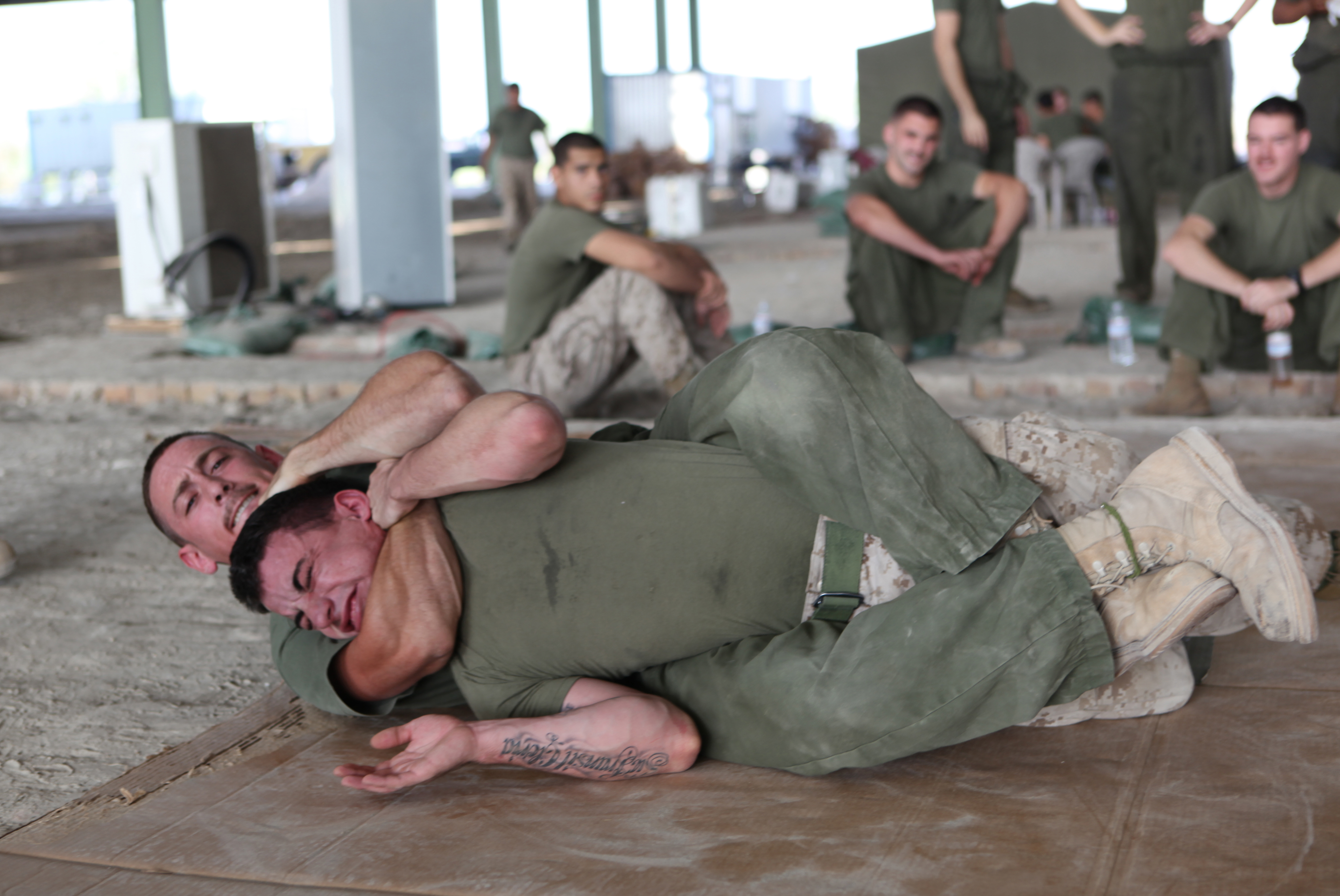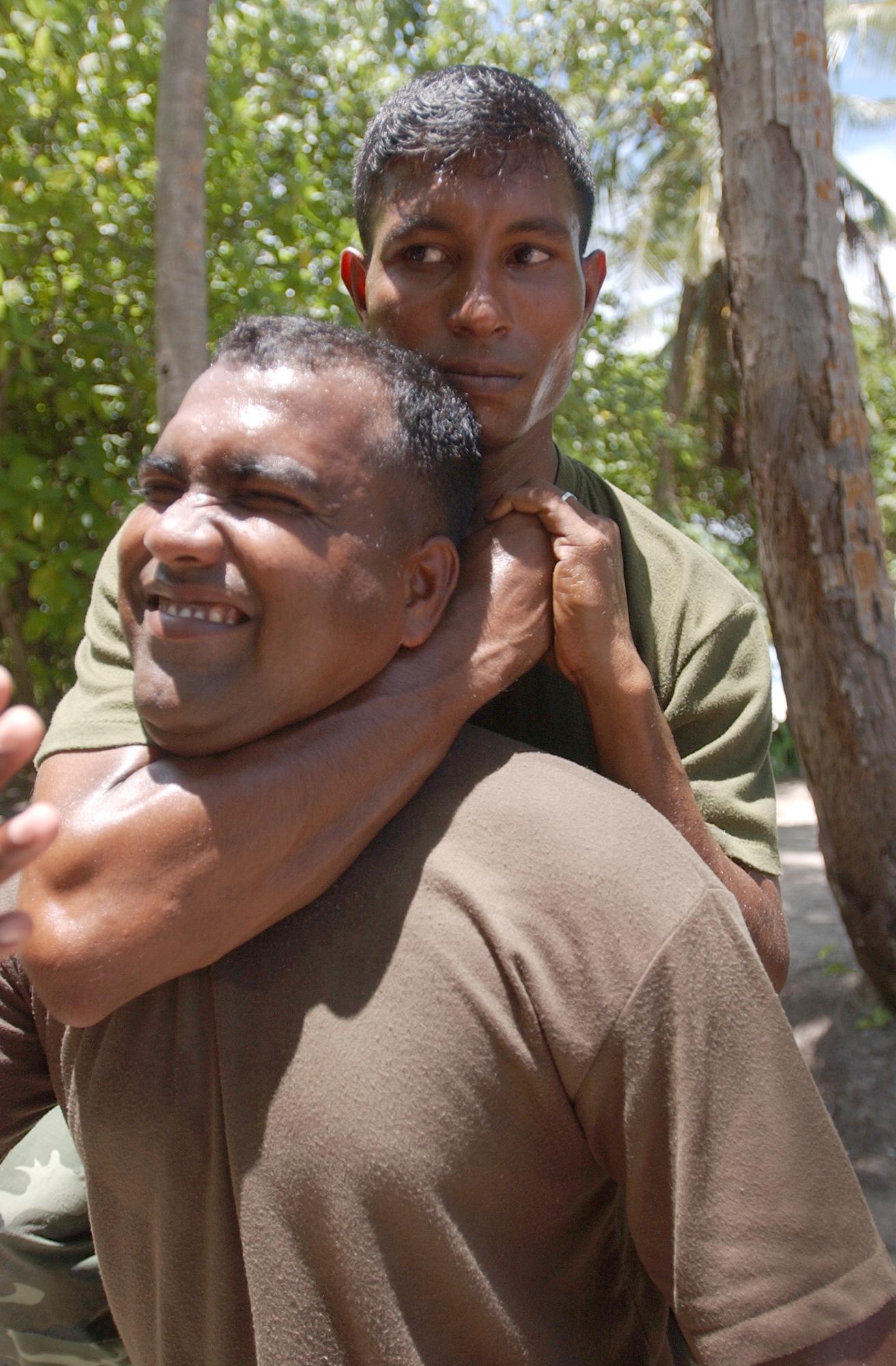Rear naked choke on:
[Wikipedia]
[Google]
[Amazon]
 The rear naked choke (RNC) is a
The rear naked choke (RNC) is a

 This variant is considered to be a "'' blood choke''" because it restricts blood flow to the brain via the carotid arteries. When applied correctly, it can cause temporary
This variant is considered to be a "'' blood choke''" because it restricts blood flow to the brain via the carotid arteries. When applied correctly, it can cause temporary 
 The rear naked choke (RNC) is a
The rear naked choke (RNC) is a chokehold
A chokehold, choke, stranglehold or, in Judo, shime-waza ( ja, 絞技, translation=constriction technique) is a general term for a grappling hold that critically reduces or prevents either air (choking)''The New Oxford Dictionary of English'' ...
in martial arts
Martial arts are codified systems and traditions of combat practiced for a number of reasons such as self-defense; military and law enforcement applications; competition; physical, mental, and spiritual development; entertainment; and the preser ...
applied from an opponent's back. The word "naked" in this context suggests that, unlike other strangulation techniques found in jujutsu/judo, this hold does not require the use of a keikogi ("gi") or training uniform.
The choke has two variations: in one version, the attacker's arm encircles the opponent's neck and then grabs their own biceps on the other arm (see below for details); in the second version, the attacker clasps their hands together instead after encircling the opponent's neck. Recent studies have shown that the rear-naked choke takes an average of 8.9 seconds to render an opponent unconscious regardless of the grip that is used.
"Figure four" or "short" variation

 This variant is considered to be a "'' blood choke''" because it restricts blood flow to the brain via the carotid arteries. When applied correctly, it can cause temporary
This variant is considered to be a "'' blood choke''" because it restricts blood flow to the brain via the carotid arteries. When applied correctly, it can cause temporary unconsciousness
Unconsciousness is a state in which a living individual exhibits a complete, or near-complete, inability to maintain an awareness of self and environment or to respond to any human or environmental stimulus. Unconsciousness may occur as the r ...
in a few seconds. The following is a description of this technique using the right arm:
#The attacker's right arm encircles the opponent's neck, with the opponent's trachea
The trachea, also known as the windpipe, is a cartilaginous tube that connects the larynx to the bronchi of the lungs, allowing the passage of air, and so is present in almost all air- breathing animals with lungs. The trachea extends from t ...
at the crook of the elbow.
#The attacker's right hand then grasps their own upper left arm iceps
#The left hand is placed behind (or occasionally on top of) the opponent's head. A more effective form of the choke can be applied by placing the palm of the left hand against the attacker's own shoulder rather than behind the opponent's head. This greatly reduces the escape possibilities.
#The elbows are then brought together such that lateral pressure, from the biceps and radius bone, is applied to the neck on both sides.
When applied properly, unconsciousness occurs in less than 10 seconds and recovery from the choke is just as quick.

"Body lock" or "hooks" variation
The placement of the legs usually falls into two categories. The first is a body lock. The attacker places one of their legs across the stomach or lower chest of the victim. They then place their other leg over their own shin, creating a figure-four with their legs. This allows them to limit movement and stay close to the back of their victim. This technique was used by Anderson Silva againstDan Henderson
Daniel Jeffery Henderson (born August 24, 1970) is an American retired mixed martial artist and Olympic wrestler, who last competed as a middleweight in the Ultimate Fighting Championship. He was the last Strikeforce Light Heavyweight Champ ...
and by Jim Miller against Melvin Guillard. The other common technique is known as using " hooks". In this version the attacker places their legs inside of the victim's legs. They then move their legs out, placing their shin behind the victim's knees, essentially using their shins and feet as hooks to control the victim's legs. This variation leaves the attacker open to the possibility of leglocks from their opponent, as they are attacking the choke.
"Clasping hands" variation
This variation (also known as Palm to Palm) has the supporting hand clasp the hand of the choking arm, allowing more pressure to be applied to the neck, but losing some of the control of the head. This alters the choke somewhat so that it is more likely to be applied as an airway-restricting choke or mixed blood and air choke, which results in more pain but a slower choke-out. As such, this technique is less frequently used at advanced levels in Judo. Nonetheless, it has seen some successful applications in mixed martial arts competition: for instance, it was used by Fedor Emelianenko, a heavyweight champion inPRIDE
Pride is defined by Merriam-Webster as "reasonable self-esteem" or "confidence and satisfaction in oneself". A healthy amount of pride is good, however, pride sometimes is used interchangeably with "conceit" or "arrogance" (among other words) w ...
, to defeat Kazuyuki Fujita
is a Japanese professional wrestler, mixed martial artist and a former amateur wrestler, currently signed to Pro Wrestling Noah, where he is a one-time GHC Heavyweight Champion. He has most recently fought in Road FC, but is also known fo ...
at the ''PRIDE 26'' event in 2003. Fujita tapped out about five seconds after the choke was applied. He used it again to defeat former UFC Heavyweight Champion
Ultimate Fighting Championship (UFC) champions are fighters who have won UFC championships.
Historical notes
At the time of the UFC's inception in 1993, mixed martial arts was not sanctioned in the United States, and did not include weight class ...
Tim Sylvia in 36 seconds. Sylvia tapped out immediately once the choke was sunk in and after the fight described it as being very painful. It was also used by Ultimate Fighting Championship
The Ultimate Fighting Championship (UFC) is an American mixed martial arts (MMA) promotion company based in Las Vegas, Nevada. It is owned and operated by Zuffa, a wholly owned subsidiary of Endeavor Group Holdings. It is the largest MMA ...
fighter Matt Hughes to defeat Frank Trigg in their second fight which was adapted from a hand-on-biceps version of the rear naked choke.
Anderson Silva also used the clasping hands variation when he defeated Dan Henderson in the UFC. Joe Lauzon used this choke in his fight against Melvin Guillard, initially using the standard version, then switching to a palm to palm.
Judo
In Judo, the rear naked choke is known as Hadaka-jime (): "naked choke", one of the 36 constriction techniques of KodokanJudo
is an unarmed modern Japanese martial art, Olympic sport (since 1964), and the most prominent form of jacket wrestling competed internationally.『日本大百科全書』電子版【柔道】(CD-ROM version of Encyclopedia Nipponica, "Judo") ...
in the Shime-waza
A chokehold, choke, stranglehold or, in Judo, shime-waza ( ja, 絞技, translation=constriction technique) is a general term for a grappling hold that critically reduces or prevents either air (choking)''The New Oxford Dictionary of English'' ( ...
list.
Technique
The main characteristic of Hadaka-Jime when compared with other Judo chokes is that it does not require the use of the opponent's clothing, namely their gi lapel, to create the chokingtourniquet
A tourniquet is a device that is used to apply pressure to a limb or extremity in order to stop the flow of blood. It may be used in emergencies, in surgery, or in post-operative rehabilitation.
A simple tourniquet can be made from a stick an ...
. It digs the blade of the wrist into the carotid sinus
In human anatomy, the carotid sinus is a dilated area at the base of the internal carotid artery just superior to the bifurcation of the internal carotid and external carotid at the level of the superior border of thyroid cartilage. The carot ...
similar to the hand clasp method and uses a lever motion helped by the underhand. It is faster to apply requiring less strength than the figure four/mixed-martial arts version but is more difficult to learn. It is not an air choke but a carotid
In anatomy, the left and right common carotid arteries (carotids) (Entry "carotid"
in
Hadaka Jime is also recognized as Hadaka-Jime-San in Danzan Ryu jujitsu's twenty-five techniques in the ''Shimete'' list. Danzan Ryu also recognizes the
 The Sleeper Hold was originated in professional wrestling by Evan Lewis in the 1880s when pro wrestling was still a legitimate contest. Lewis earned the nickname "Strangler" for his use of the hold and was an accomplished catch wrestler using the hold defeating Ernst Roeber for the world championship before eventually losing the title to Martin Burns. In the southeastern United States this move was also known as the Charleston Choke.
Modern
The Sleeper Hold was originated in professional wrestling by Evan Lewis in the 1880s when pro wrestling was still a legitimate contest. Lewis earned the nickname "Strangler" for his use of the hold and was an accomplished catch wrestler using the hold defeating Ernst Roeber for the world championship before eventually losing the title to Martin Burns. In the southeastern United States this move was also known as the Charleston Choke.
Modern
Rear naked choke BJJ instructions
{{Use dmy dates, date=June 2020 Grappling positions Chokeholds
in
Hadaka Jime is also recognized as Hadaka-Jime-San in Danzan Ryu jujitsu's twenty-five techniques in the ''Shimete'' list. Danzan Ryu also recognizes the
Guillotine choke
The guillotine choke, also known as Mae Hadaka Jime (前裸絞, "front naked choke"; compare to a rear naked choke) in judo, is a chokehold in martial arts applied from in front of the opponent, often on the ground but can also be done while stan ...
as Hadaka-Jime-Ichi. But the principle is the same as Jiu-Jitsu
Jujutsu ( ; ja, link=no, 柔術 , ), also known as jiu-jitsu and ju-jitsu, is a family of Japanese martial arts and a system of close combat (unarmed or with a minor weapon) that can be used in a defensive or offensive manner to kill or subd ...
's ground version.
Included systems
Systems: *Kodokan
The , or ''Kōdōkan'' (講道館), is the headquarters of the worldwide judo community. The ''kōdōkan'' was founded in 1882 by Kanō Jigorō, the founder of judo, and is now an eight-story building in Tokyo. Etymology
Literally, ''kō'' ...
Judo
is an unarmed modern Japanese martial art, Olympic sport (since 1964), and the most prominent form of jacket wrestling competed internationally.『日本大百科全書』電子版【柔道】(CD-ROM version of Encyclopedia Nipponica, "Judo") ...
, Judo Lists
* Danzan Ryu jujitsu, Danza Ryu Lists
Lists:
* The Canon Of Judo
* Judo technique
Hasami-jime
Kyuzo Mifune
has been categorized as one of the greatest exponents of the art of judo after the founder, Kanō Jigorō. He is considered by many to be the greatest judo technician ever, after Kanō.
Early life
Mifune was born on April 21, 1883, in Kuji Cit ...
demonstrates Hasami-Jime in The Essence of Judo and is described in ''The Canon Of Judo''.*
Others
Danzan Ryu enumerates three versions of Hadaka-Jime: ;1. Ichi (one): Standing neck-break. Two versions: ;# Neck twist ;# Guillotine ::A version of the guillotine, Mae-Hadaka-Jime, is also described in '' The Canon Of Judo'', an authoritative work that covers the history of judo and its predecessor jujutsu. ;2. Ni (two): Choke with forearm. This is an air choke with the forearm pressing on the throat. ;3. San (three): Figure-4 choke with forearm. This is a blood choke with the forearms and biceps pressing and the sides of the neck."Sleeper hold" in professional wrestling
 The Sleeper Hold was originated in professional wrestling by Evan Lewis in the 1880s when pro wrestling was still a legitimate contest. Lewis earned the nickname "Strangler" for his use of the hold and was an accomplished catch wrestler using the hold defeating Ernst Roeber for the world championship before eventually losing the title to Martin Burns. In the southeastern United States this move was also known as the Charleston Choke.
Modern
The Sleeper Hold was originated in professional wrestling by Evan Lewis in the 1880s when pro wrestling was still a legitimate contest. Lewis earned the nickname "Strangler" for his use of the hold and was an accomplished catch wrestler using the hold defeating Ernst Roeber for the world championship before eventually losing the title to Martin Burns. In the southeastern United States this move was also known as the Charleston Choke.
Modern pro wrestling
Professional wrestling is a form of theater that revolves around staged wrestling matches. The mock combat is performed in a ring similar to the kind used in boxing, and the dramatic aspects of pro wrestling may be performed both in the ring o ...
's first "sleeper hold", technically different from a choke, which is a compression of the throat and/or adam's apple
The Adam's apple or laryngeal prominence is the protrusion in the human neck formed by the angle of the thyroid cartilage surrounding the larynx, typically visible in men, less frequently in women.
Structure
The topographic structure which is e ...
, is thought to have been performed by Jim Londos on 29 June 1931. Suspicion abounded as to the nature of Londos' move (which had looked suspiciously like a choke against the windpipe); however, Londos was quoted the next day in ''The New York Sun
''The New York Sun'' is an American online newspaper published in Manhattan; from 2002 to 2008 it was a daily newspaper distributed in New York City. It debuted on April 16, 2002, adopting the name, motto, and masthead of the earlier New Yor ...
'' as simply having performed "a new hold I perfected which shuts off the jugular vein
The jugular veins are veins that take deoxygenated blood from the head back to the heart via the superior vena cava. The internal jugular vein descends next to the internal carotid artery and continues posteriorly to the sternocleidomastoid mu ...
."
Though Londos' original move may or may not have been inspired by judo's "hadaka jime", pro-wrestling's sleeper and a rear naked choke both share a similar style of execution. However, in order for the sleeper to be used in the performance art-related world of pro-wrestling, the leverage arm is positioned in a relaxed state so the hold is not fully applied.
It is more realistically used by All Elite Wrestling
All Elite Wrestling (AEW) is an American professional wrestling promotion based in Jacksonville, Florida. It is considered the second largest wrestling promotion in the United States behind WWE.
AEW is owned by Shahid Khan and his son Tony, ...
wrestler Samoa Joe
Nuufolau Joel Seanoa (born March 17, 1979), is an American professional wrestler better known by the ring name Samoa Joe who is currently signed to All Elite Wrestling (AEW). Joe is currently a double champion - in his first reign both as AE ...
(whose wrestling move-set is closer to mixed martial arts). The move has become more of a staple among independent wrestlers, as well as the Japan
Japan ( ja, 日本, or , and formally , ''Nihonkoku'') is an island country in East Asia. It is situated in the northwest Pacific Ocean, and is bordered on the west by the Sea of Japan, while extending from the Sea of Okhotsk in the n ...
ese wrestlers with the "strong style" of the sport; the most notable being former MMA star Minoru Suzuki.
Catch wrestling's sleeper
In moderncatch wrestling
Catch wrestling (originally catch-as-catch-can) is a classical hybrid grappling style and combat sport. It was developed by J. G. Chambers in Britain . It was popularised by wrestlers of travelling funfairs who developed their own submission ...
circles, the term "sleeper hold" refers to a variation of the rear naked choke in which the individual performing the hold snakes the leverage arm across the opponent's throat (in the same manner as the traditional rear naked choke) and grasps their opposite shoulder, rather than the biceps. The opposite hand is also placed against the base of the opponent's skull in the form of a closed Hammer Fist
A punch is a striking blow with the fist. It is used in most martial arts and combat sports, most notably boxing, where it is the only type of offensive technique allowed. In sports, hand wraps or other padding such as gloves may be used to prot ...
, or on top of the head. The attacking wrestler then squeezes their elbows together, pushes forward with the hammer fist (if used), and crunches forward with the abdominal
The abdomen (colloquially called the belly, tummy, midriff, tucky or stomach) is the part of the body between the thorax (chest) and pelvis, in humans and in other vertebrates. The abdomen is the front part of the abdominal segment of the to ...
muscles, producing an extremely tight and fast-acting choke.
Safe application
This choke, in either the figure-four or clasped-hand variation, is an extremely dangerous technique if used thoughtlessly or improperly. When applied as a blood choke in particular, it immediately reduces the supply of oxygen to the brain, leading (as mentioned above) to unconsciousness and ultimately (if not released) tobrain damage
Neurotrauma, brain damage or brain injury (BI) is the destruction or degeneration of brain cells. Brain injuries occur due to a wide range of internal and external factors. In general, brain damage refers to significant, undiscriminating t ...
or death. It is imperative, when using this technique, to be completely aware of your opponent's physical state, and to release the choke at any sign of your opponent losing consciousness. From the sport's inception, no fatalities have been reported as due to choking in judo.
See also
* Back mount *Chokehold
A chokehold, choke, stranglehold or, in Judo, shime-waza ( ja, 絞技, translation=constriction technique) is a general term for a grappling hold that critically reduces or prevents either air (choking)''The New Oxford Dictionary of English'' ...
* Fainting
* Submission (combat sport)
References
External links
Rear naked choke BJJ instructions
{{Use dmy dates, date=June 2020 Grappling positions Chokeholds